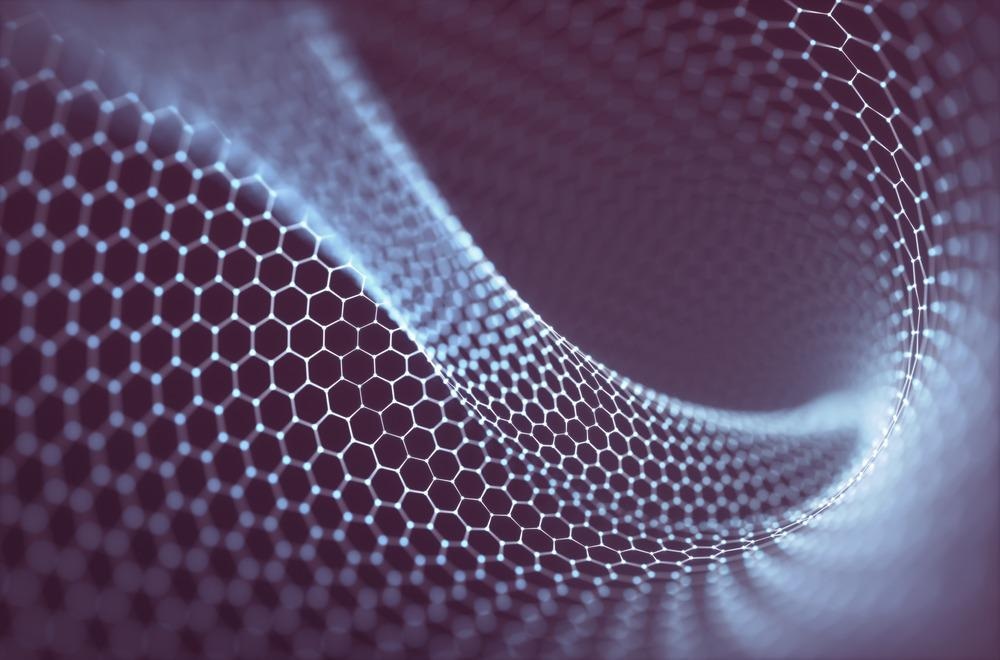Anticipating future demand for infrastructure in space, researchers and industrial partners focus on the development of some of the most innovative technologies, materials, and construction methods that would enable the creation of inhabitable space structures. According to experts, graphene might be the perfect material capable of boosting space exploration in many ways.

Image Credit: Gorodenkoff/Shutterstock.com
If human society is ever going to embark on an expansive space exploration course, we are going to need radically new materials and technologies. With space agencies such as NASA, Roscosmos, and the European Space Agency (ESA) aiming to expand their long-term presence in space in the coming years with projects such as the Lunar Gateway and the forthcoming moon landings, international research collaborations aim to develop the necessary technologies that would enable creating safer habitats and spacecraft with efficient life support and propulsion systems.
Graphene with its unique thermal, electrical, and mechanical properties is regarded as an ideal candidate for future aerospace applications. The material is abundant on our planet (and potentially on others too), easy to manufacture and manipulate, and super-strong - a single atomic layer of graphene is 200 times stronger than steel.
The material conducts heat and electricity better than any other material while transmitting 97% of the sunlight to pass through, making it an ideal material for a wide range of applications, such as structural support, thermal management, solar energy conversion, and many others.
How Graphene-Enhanced Thermal Management Can Change Space Habitation?
The exceptional thermal properties of graphene can offer a solution to one of the most challenging problems of space exploration - keeping the spacecraft at the right temperature. The temperature difference between the sun-facing and shadow sides of a spacecraft can reach 200 °C. Managing such extreme temperature fluctuations is crucial for spacecraft to function properly in space.
A series of experiments conducted by scientists from the Graphene Flagship (an EU-funded research collaboration aiming to bring graphene innovation out of the lab and into commercial applications) explored the possibility of using graphene to improve space thermal management systems, loop heat pipes in particular, in zero-gravity conditions during two parabolic microgravity ESA flights. The heat pipes provide cooling to electronic equipment by evaporating fluid inside a wick made from porous metal.
What Space Habitation’s Closed-Loop Technologies Can Teach Us About Sustainability
The experiments demonstrated that applying graphene coating on the exterior of the wick improved the efficiency of loop heat pipes, increased the heat transfer rates, and kept equipment at optimal conditions for long periods, which is essential to autonomous space exploration.
Propelling Spacecraft with Graphene Light-Sails
Light-sail propulsion requires no fuel. Instead, it relies on harnessing the radiation pressure of sunlight, thus making the light-sail spacecraft much lighter and easier to launch. Light-sails need to be highly reflective, lightweight, and mechanically very robust.
The technology has been demonstrated by two spacecraft launched in the past decade fitted with light-sails made of polyimide and mylar (a polyester material). These experimental light-sails consisted of a nanometer-thick reflective layer supported by a micrometer-thick substrate, ensuring the necessary sturdiness.
Such a combination, however, results in a light-sail mass that is too high to be efficiently used for deep-space exploration. Researchers from ESA's GrapheneSail team are exploring the possibility of using graphene to build much lighter and stronger kilometer-wide light-sails. In scaled-down experiments, the scientists dropped free-floating graphene membranes down the 146 meter-tall ZARM Drop Tower in Germany to simulate microgravity conditions and investigate the graphene behavior when exposed to radiation pressure from lasers. Shining a 1-Watt laser at the scaled-down light-sail accelerated it by 1 m/s2. Large-scale light-sails could continually accelerate at that rate, thus driving a spacecraft to very high speeds.
Strengthening Habitable Space Structures with Graphene
Perhaps the most exciting application of graphene, related to space habitation, is the development of novel lightweight composite materials that could provide structural advantages to future inhabited space structures and designing advanced manufacturing processes involving these materials.

Image Credit: ktsdesign/Shutterstock.com
Experts from the University of Manchester have teamed up with a global architecture firm Skidmore, Owings & Merrill, a global architectural and engineering firm responsible for some of the landmark buildings around the world like the world’s tallest Burj Khalifa, to develop a scaled-down prototype of a space habitat assembled from graphene-enhanced materials. Bringing their expertise into the research, the architects aim to combine some of the most innovative materials and manufacturing methods with their experience in designing inhabited environments.
Besides structural robustness, incorporating graphene in the architectural elements of the habitat model also provides combined radiation shielding and thermal management capabilities. According to the researchers, integrating graphene-based materials with automated design and manufacturing processes can dramatically improve the performance of composite light-weight structures, not only for space habitation applications but a future use on Earth as well.
These examples of advanced research and development efforts further underline the extent of future graphene applications and their potential to revolutionize the global space exploration industry.
References and Further Reading
Huang, P., at al. (2021) Graphene film for thermal management: A review. Nano Materials Science 3, 1-16. Available at: https://doi.org/10.1016/j.nanoms.2020.09.001
M. S. Williams (2021) The Technologies That Could Finally Make Space Elevators a Reality [Online] www.interestingengineering.com Available at: https://interestingengineering.com/tech-that-can-make-space-elevators-a-reality (Accessed on 23 November 2021)
S. Chapman (2021) One giant leap as Manchester reveals graphene space habitats [Online] www.prolificnorth.co.uk Available at: https://www.prolificnorth.co.uk/news/tech-news/2021/10/one-giant-leap-manchester-reveals-graphene-space-habitats (Accessed on 23 November 2021).
European Space agency (2020) One Atom Thick Graphene Light Sail Could Speed Journey to Other Star Systems [Online] www.scitechdaily.com Available at: https://scitechdaily.com/one-atom-thick-graphene-light-sail-could-speed-journey-to-other-star-systems (Accessed on 23 November 2021).
Gaudenzi, R., at al. (2020) Light-induced propulsion of graphene-on-grid sails in microgravity. Acta Astronautica 174, 204-210. Available at: https://doi.org/10.1016/j.actaastro.2020.03.030
CORDIS (2020) From flagship to spaceship—two experiments pushing the frontier of graphene's potential [Online] www.phys.org Available at: https://phys.org/news/2018-01-flagship-spaceshiptwo-frontier-graphene-potential.html (Accessed on 23 November 2021).
Disclaimer: The views expressed here are those of the author expressed in their private capacity and do not necessarily represent the views of AZoM.com Limited T/A AZoNetwork the owner and operator of this website. This disclaimer forms part of the Terms and conditions of use of this website.